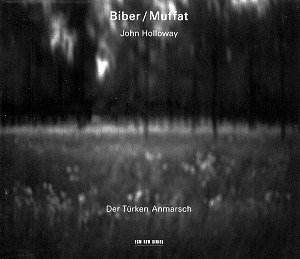This is an enchanting
recording of violin sonatas of Heinrich
Biber (Kapellmeister in Salzburg) and
Georg Muffat. In fact I’ve been returning
to this disc again and again over the
past few weeks. One of many highlights
is the Muffat Sonata Violino Solo in
D major (1677), which opens and closes
with an incredibly simple yet hugely
effective theme that is lovingly played.
What I like about the violin playing
is its depth, rhythmic flexibility (some
nice inégalité), pure
tone and sophistication. The playing
sounds spontaneous, is at times startling,
at times melancholy. Underpinning the
violin delights are a continuo of both
organ and harpsichord which provide
sustaining quality and rhythmic impetus
respectively. The recording also allows
the continuo instruments to be clearly
heard rather than being merely ‘an accompaniment.’
Four of Biber’s Violin
Sonatas from the collection Sonatae
Violino solo of 1681 are also performed,
music described by Peter Wollny thus:
‘Never before had there been such a
poised synthesis of challenging virtuosity,
artistic expression and intricate craftsmanship.’
The sonatas often alternate
slow and fast movements like the Italian
Sonata da Chiesa. The Sonata in A opens
with improvisation-like flourishes in
free time over a tonic pedal before
moving to more metrical writing. The
harmonies underlying this are invariably
simple yet highly effective. A more
dance-like section in Allegro tempo
follows with dotted rhythms before the
violin introduces Lombardic rhythms
and a variation on the previous repeating
harmonies. Another Presto section follows
with more elaborate harpsichord figuration.
The tonality is A major throughout which
gives the multiple sections a cohesive
quality. The toccata patterns and freedom
of the opening return towards the end.
The disc opens with
Andreas Anton Schmelzer’s adaptation
of Biber’s Tenth Rosary Sonata from
the ‘Mystery Cycle.’ It portrays in
music the ‘Victory of the Christians
over the Turks’ in Vienna in 1683. The
piece comprises an introductory section,
aria and four variations and finale.
Attached to the different sections are
programme notes explaining the action
they represent. The rapid changes of
affekt keep the listener engaged until
the last note has been played.
The booklet contains
texts in English and German, and some
imaginative photographs.
A superb disc and therefore
a must-have.
Graham Mark Scott







